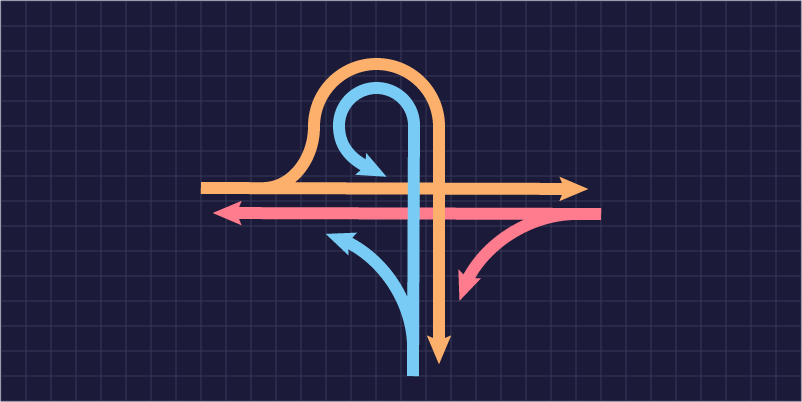The trumpet is the oldest way to grade-separate a three way junction - your basic free-flowing way to end one motorway on another. It's a close sibling of the cloverleaf, both layouts originating in the 1920s, which is why both are heavy on land use and light on construction work.
Limited-access roads
Surface roads
Vertical levels
Bridges required
Access between roads
Number in UK
First built in UK
Other countries with extensive motorway networks generally have far more trumpet interchanges than the UK does. There are several reasons for that. The first is the same reason that explains a lot about our motorways: we started late.
The first trumpet interchange in the UK opened in 1959, at M1 J8 Breakspears Interchange near Hemel Hempstead (it was completely rebuilt in the early 2000s and the original junction is gone), though they had appeared in plans for roads as far back as the 1930s. 1959 was only two years before we got our first triangle interchange, an altogether more sophisticated affair.
The second reason is that trumpets typically take up a lot of room - that loop isn't very efficient in terms of land use - and in the UK space is often at a premium.
The third, less obvious, reason is that the UK does not have a tolled motorway network. The trumpet is the mainstay of the toll road: at junctions, a normal junction design with four sliproads connecting to the local road network would require four toll plazas. With a trumpet, you gather all the sliproads together and you can have just one toll plaza. French autoroutes and US turnpikes are stuffed with trumpet junctions for this very reason. The UK does, of course, have one tolled motorway, the M6 Toll: three of its eight junctions provide entrances and exits in all directions, and all three of them are trumpets.

Why build one?
If you're building a tolled motorway, the reason is clear: the trumpet is the échangeur aux choix for the discerning toll route operator. The trumpet allows you to install just one toll plaza for each interchange, and remains reasonably cheap to build.
If you're not building a toll route, there are still plenty of uses for this venerable design - it doesn't suffer the same sort of drawbacks as its contemporary, the cloverleaf, and has never fallen from favour. If the space is available, it's a perfectly good way to terminate one road on another.
In the UK, a major consideration is always traffic levels, and a major restriction on the throughput of a trumpet interchange is the tightness of the loop sliproad. If it's small, traffic has to move slowly, causing both a reduction in capacity and a hazard if the speed of the loop is significantly slower than the speed of the roads it connects. In some cases (M6 J15 Hanchurch Interchange, we are looking at you) it can become a cause of serious, repeated accidents as fast-moving vehicles misjudge the corner and overturn. Where two motorways meet, then, you might prefer something without the loop, such as a triangle.
That is why the trumpet is most at home in the UK when it's connecting a spur to its parent motorway. A free-flowing connection, yes, but to a second-tier road, not another motorway.
Before you build your trumpet, bear in mind that best practice is to design it in such a way that the loop sliproad is for traffic entering the motorway, not leaving it, as traffic entering is likely to be slower and therefore less likely to take the corner on two wheels.
Advantages
- Low construction cost as there is only one bridge structure.
- On tolled roads, provides a cost-effective way of getting all traffic in one place for toll booths.
- Fully free-flowing.
Disadvantages
- Disorienting to navigate for those driving in the direction that uses the loop.
- Makes poor use of space, with a redundant patch of land within the loop.
- Unless the loop is very big, it can be prone to accidents.
Variations
Very occasionally the trumpet can be made into a four-way free-flowing junction with one of the arms only for straight-through movements. There is one in New Brighton on the Wirral; a more famous variation is at M25 J5 Chevening Interchange.
A more common modification than this is a trumpet where all four sliproads terminate on a roundabout, such as M6 J15 Hanchurch Interchange.
With thanks to Phil Reynolds and Simon M4Man for information on this page.

